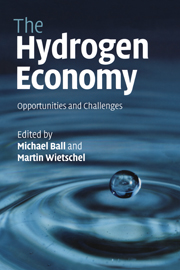Book contents
- Frontmatter
- Contents
- List of main contributors
- Preface
- Acknowledgements
- List of abbreviations
- 1 Scope of the book
- 2 Why hydrogen?
- 3 Non-renewable energy resources: fossil fuels – supply and future availability
- 4 Non-renewable energy resources: nuclear fuels
- 5 Assessment of the potentials for renewable energy sources
- 6 Carbon capture and storage
- 7 Energy-chain analysis of hydrogen and its competing alternative fuels for transport
- 8 Hydrogen today
- 9 Fundamental properties of hydrogen
- 10 Hydrogen production
- 11 Hydrogen storage
- 12 Hydrogen distribution
- 13 Key role of fuel cells
- 14 Hydrogen-infrastructure build-up in Europe
- 15 Building a hydrogen infrastructure in the USA
- 16 Hydrogen and the electricity sector
- 17 Hydrogen corridors
- 18 Macroeconomic impacts of hydrogen
- 19 Sustainable transport visions: the role of hydrogen and fuel-cell vehicle technologies
- 20 Energy-efficient solutions needed – paving the way for hydrogen
- 21 The future of hydrogen – opportunities and challenges
- Further reading
- Index
- References
10 - Hydrogen production
Published online by Cambridge University Press: 22 January 2010
- Frontmatter
- Contents
- List of main contributors
- Preface
- Acknowledgements
- List of abbreviations
- 1 Scope of the book
- 2 Why hydrogen?
- 3 Non-renewable energy resources: fossil fuels – supply and future availability
- 4 Non-renewable energy resources: nuclear fuels
- 5 Assessment of the potentials for renewable energy sources
- 6 Carbon capture and storage
- 7 Energy-chain analysis of hydrogen and its competing alternative fuels for transport
- 8 Hydrogen today
- 9 Fundamental properties of hydrogen
- 10 Hydrogen production
- 11 Hydrogen storage
- 12 Hydrogen distribution
- 13 Key role of fuel cells
- 14 Hydrogen-infrastructure build-up in Europe
- 15 Building a hydrogen infrastructure in the USA
- 16 Hydrogen and the electricity sector
- 17 Hydrogen corridors
- 18 Macroeconomic impacts of hydrogen
- 19 Sustainable transport visions: the role of hydrogen and fuel-cell vehicle technologies
- 20 Energy-efficient solutions needed – paving the way for hydrogen
- 21 The future of hydrogen – opportunities and challenges
- Further reading
- Index
- References
Summary
This chapter provides an overview of the various hydrogen production methods. In this respect, the chapter aims especially at outlining the technical fundamentals of the most important commercial processes of hydrogen production and quantifying their technical and economic parameters, which are used in the context of modelling the build-up of a hydrogen infrastructure in Chapter 14. Novel hydrogen-production technologies that still require basic research are also briefly addressed. The chapter finishes with an assessment of the availability of industrial surplus hydrogen as a potential hydrogen source for the transition phase towards its widespread use as vehicle fuel.
Overview of production processes
Since hydrogen only occurs naturally in a bonded form, it first has to be released from its various compounds by using energy. Hydrogen can be produced from all primary energy sources. Figure 10.1 shows an overview of the various relevant hydrogen-production processes and the respective primary energy sources used, differentiated into renewable and non-renewable sources.
Hydrogen can be produced directly from primary as well as from secondary energy sources. Today's commercially applied methods based on fossil raw materials include natural gas reforming and the partial oxidation of feeds with lower quality, such as petroleum coke or other refinery residues. The gasification of coal to produce hydrogen has undergone further development in the last decade and is now also a commercially available process. Apart from this, there are other methods still at the research and development stage, particularly those based on biomass, but also biological hydrogen production.
- Type
- Chapter
- Information
- The Hydrogen EconomyOpportunities and Challenges, pp. 277 - 308Publisher: Cambridge University PressPrint publication year: 2009
References
- 6
- Cited by

